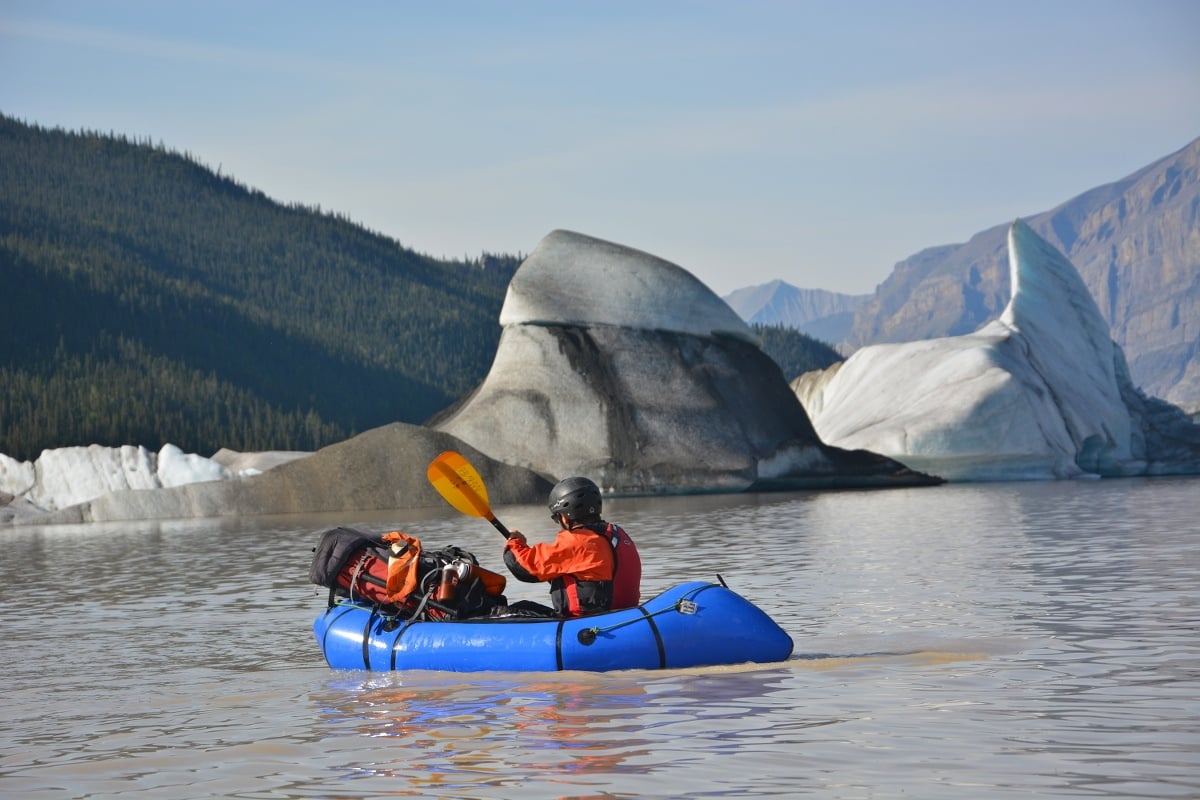Packrafting has rapidly gained popularity as an exhilarating adventure sport, offering a unique blend of backpacking and river travel.
This activity allows outdoor enthusiasts to explore remote waters and landscapes that might otherwise be inaccessible. The portability and versatility of packrafts make them ideal for traversing both land and water, opening up new opportunities for exploration and discovery.
 Photo by Tim Kelley
Photo by Tim Kelley
Packrafting Essentials: What Gear Do You Need for a Packrafting Trip?
A packrafting journey transforms ordinarily inaccessible landscapes into thrilling adventures.
Equipped with the right gear, packrafters can confidently navigate the challenges and joys of their aquatic adventures, making every trip a memorable one.
Whether floating down serene rivers and hiking backcountry trails, or tackling challenging whitewater and trekking over mountains, the gear you choose matters.
Here are some key items for your packrafting adventure:
-
Packraft: Modern packrafts are portable, lightweight inflatable boats that are designed with waterproof zippers and internal dry storage compartments. Shapes and features vary depending on the desired use, ranging from flatwater, whitewater, bikepacking, hunting, or long expedition.
- Paddle: A compact, breakdown paddle for efficient movement through the water.
- Personal Flotation Device (PFD): Required item for any river travel, providing buoyancy.
- Helmet: A helmet is essential, particularly when navigating through rapids or rocky waters.
- Repair Kit: To handle any punctures or damage to your packraft.
How to Packraft: Basic Packrafting Skills & Techniques
 Photo by Stéphane Terrier
Photo by Stéphane Terrier
Packrafting combines the thrill of paddling with the exploration of remote areas, but developing competence requires a solid grasp of various paddling techniques, safety protocols, and navigation skills.
On a NOLS packrafting course, we integrate the following skills and techniques into our comprehensive packrafting curriculum in order to prepare students not just to enjoy packrafting as a recreational activity but to handle the challenges of dynamic aquatic environments competently.
Here’s a deeper dive into each component to enhance your packrafting skillset:
Paddling Techniques:
- Forward Stroke: The forward stroke is the primary propulsion method taught in NOLS packrafting courses. Our instructors emphasize maintaining an upright posture for effective power transfer. Students learn to grip the paddle with hands shoulder-width apart, fully immersing one blade in the water near the boat, and pulling it back towards the hip while rotating the torso. This technique not only maximizes power with minimal fatigue but also ensures a straight trajectory, a foundational skill for efficient packrafting.
- Sweep Stroke: Turning the packraft efficiently is achieved through the sweep stroke, which is practiced widely in our courses. By extending the paddle blade away from the packraft in a wide arc from the bow to the stern, students learn how the width of the arc influences the sharpness of the turn. This technique is crucial for maneuvering through challenging routes that require precise handling.
- Bracing: Stability in turbulent waters is maintained through effective bracing techniques. NOLS students are taught to keep the paddle blade flat against the water’s surface to create resistance that prevents capsizing. This skill is vital for navigating through sudden shifts in water dynamics and is practiced in both calm and challenging conditions.
 Photo by Stéphane Terrier
Photo by Stéphane Terrier
Self-Rescue Skills:
- Self-Rescue: If you capsize, the first rule is to stay calm. Hold onto your paddle and packraft, and then assess the situation. On a NOLS packrafting course, students practice various self-rescue techniques in flat water to develop competence and comfort before moving on to whitewater.
- Swimming Skills: Always wear a PFD, and practice swimming in moving water. Techniques like the defensive and aggressive swimming positions can be used depending on the nature of the water you are navigating. These skills are critical for moving safely to a riverbank or through rapids.
Navigation & River Reading:
- Eddies: Eddies are calm pockets of water behind obstacles, which can serve as safe zones in strong currents. To enter an eddy, paddle towards it and execute a sharp eddy turn using your sweep stroke as you cross the eddy line, where the water’s direction changes.
- Rapids: Navigating rapids requires identifying a low-risk 'line' through the rapid, often marked by smoother water between waves and obstacles. Approach rapids squarely, paddling strongly to maintain control. You should plan several moves in advance, adapting as necessary.
- Hazards: Common hazards include submerged rocks, fallen trees (strainers), and sudden drops. Always scout difficult sections of river from the shore if possible. Avoid obstacles by steering clear early, using strong, decisive paddle strokes.
Mastering these techniques and understanding the river environment enhances your safety and enjoyment in packrafting. Always continue learning and practicing, and consider taking courses from experienced instructors to refine your skills further.
Risk Management Considerations and Best Practices
1. Never Packraft Alone:
- Safety in Numbers: Always have at least one other person with you when you go packrafting. Having a partner can be invaluable in case of emergencies like capsizing, injury, or equipment failure. A partner can provide immediate assistance, whether it's helping right a capsized boat, performing first aid, or seeking help.
- Shared Experience: Besides safety, packrafting with others can enhance the overall experience, allowing for shared workload in navigating and setting up camp, as well as the enjoyment and memories created together.
2. Emergency Preparation:
- Personal Flotation Device (PFD): Again, a PFD is essential for providing buoyancy.
- Whistle: A whistle is a simple, yet effective tool for signaling help. It’s lightweight, doesn’t require power, and the sound carries far and wide, even in adverse weather conditions. Three blasts of a whistle is a universally recognized distress signal.
- First Aid Kit: Carry a well-stocked first aid kit tailored to the nature and duration of your trip. At a minimum, it should include items for wound care, blisters, burns, sprains, and strains, as well as any personal medications. Know how to use each item in your kit.
- Communication Device: In areas with cell service, a fully charged mobile phone in a waterproof case can be a lifeline. For remote areas, consider a satellite phone or a personal locator beacon (PLB). These devices can send out a distress signal to emergency services pinpointing your exact location.
- Dry Bags: Keep all emergency gear in waterproof “dry” bags to ensure functionality when needed most.
3. Weather and Environmental Awareness:
- Check Weather Forecasts: Always check the weather forecast before departure and continue monitoring it. Sudden weather changes can lead to dangerous situations, such as rising water levels and fast-moving currents.
- Understand the Environment: Familiarize yourself with the packrafting area. Understanding the typical and current river conditions, wildlife issues, and any unique risks can help you avoid dangerous situations.
4. Skill Development and Knowledge:
- Learn Basic Skills: Before heading out, ensure you have a solid foundation in basic packrafting skills, including paddling techniques, self-rescue, and water reading. Consider taking a course from a professional instructor. In 2025, NOLS will offer a multi-day expedition course for those interested in gaining hands-on packrafting instruction in the most beautiful and remote locations in Alaska.
- Practice Scenarios: Regularly practice emergency scenarios like flipping your raft, swimming in currents, and using your communication device. Knowing how to react calmly and efficiently can make a significant difference in real situations.
5. Proper Gear and Equipment Check:
- Regular Inspections: Before each trip, thoroughly inspect your packraft, paddle, and safety gear for any damage or wear that could compromise their functionality. Ensure repairs are made before you head out.
- Appropriate Gear: Use gear that is suitable for the specific conditions of your trip. For example, colder environments may require a dry suit and additional thermal layers to prevent hypothermia.
Environmental Awareness in Packrafting
Packrafting offers a unique way to explore natural landscapes, but it also carries the responsibility of minimizing our impact on these environments.
Practicing environmental awareness ensures that these beautiful places remain pristine for future adventurers. By incorporating these practices into your packrafting adventures, you contribute to the preservation of these environments.
Here’s how to enhance your environmental awareness while packrafting:
 Photo by Stéphane Terrier
Photo by Stéphane Terrier
Leave No Trace Principles
- Plan Ahead and Prepare: Understand the regulations and special concerns of the area you will visit. Prepare for extreme weather, hazards, and emergencies.Travel and Camp on Durable Surfaces: Use established trails and campsites. Keep off of fragile vegetation and soft ground surrounding waterways.
- Dispose of Waste Properly: Pack out all trash, leftover food, and litter. Utilize toilet facilities or carry a portable waste disposal system if none are available. Disperse all wash water.
- Leave What You Find: Avoid altering sites, moving rocks, picking plants, or introducing non-native species. Preserve the past: examine, but do not touch, cultural or historic structures and artifacts.
- Minimize Campfire Impacts: Use a lightweight stove for cooking and enjoy a candle lantern for light. Where fires are permitted, use established fire rings and keep fires small.
- Respect Wildlife: Observe wildlife from a distance and do not follow or approach them. Never feed animals, as it damages their health and alters natural behaviors.
- Be Considerate of Other Visitors: Respect other users and protect the quality of their experience. Be courteous on the water and at shared campsites.
Reducing Your Impact
Avoid Disturbing Wildlife
Packrafting can lead you into remote areas that are often wildlife habitats. It's important to observe animals without disturbing them. Sudden movements, noises, and getting too close can stress animals, leading to negative impacts on their feeding and breeding behaviors.
Limit Chemical Contamination
Be cautious about the substances you bring into natural environments. Sunscreens, insect repellants, and body lotions can wash off in the water and introduce chemicals that may be harmful to aquatic life. Opt for biodegradable and eco-friendly products whenever possible.
Be Mindful of Aquatic Ecosystems
The lightweight nature of packrafts means they can access very shallow and sensitive waterways. Always be mindful of aquatic plants and the riverbed. Avoid dragging your packraft over the riverbed in shallow waters to prevent scraping off periphyton, algae, and small invertebrates that form the base of the aquatic food web.
Reduce the Spread of Invasive Species
Clean your gear thoroughly before and after trips to avoid transporting non-native plant seeds or invasive aquatic species across water systems. This includes cleaning your packraft, paddle, boots, and any wet gear.
Join NOLS for Your Next Packrafting Experience!
Whether you're a novice or an experienced packrafter, NOLS has your back for your next packrafting adventure. Sign up for one of our upcoming packrafting trips & courses to gain hands-on experience and make the most of this exciting adventure sport. Happy packrafting!
Check out our whitewater adventure courses and backpacking trips and courses, too!
Written By
NOLS
NOLS is a nonprofit global wilderness school that seeks to help you step forward boldly as a leader.



